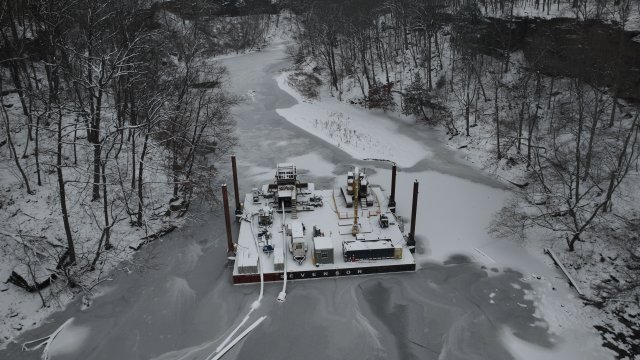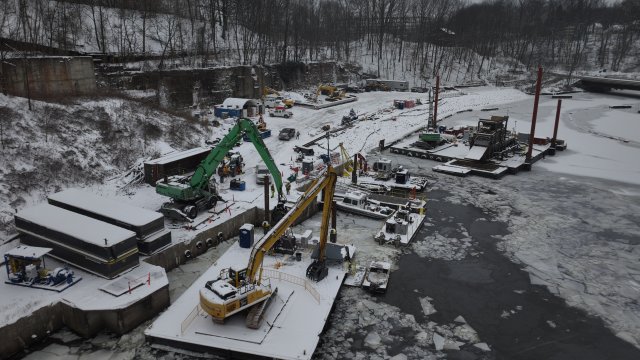Cuyahoga Gorge Dam Great Lakes Legacy Act Cleanup
On this page:
Events
Future events will be posted here.
Background
The U.S. Environmental Protection Agency (EPA) and several non-federal sponsors are beginning a remedial or cleanup project to remove contaminated sediments from behind the Gorge Dam on the Cuyahoga River within Cuyahoga Falls and Akron, Ohio under the Great Lakes Legacy Act. EPA estimates 865,200 cubic yards of contaminated sediment from behind the Gorge Dam will be remediated. Remediation includes removal, transportation, stabilization, and placement of dredged material to take place over the course of two construction seasons.
The purpose of the project is to address contaminants of concern in the Gorge Dam pool sediments. The contaminants are primarily polycyclic aromatic hydrocarbons, or PAHs, polychlorinated biphenyls (PCBs), oil and grease, and various heavy metals including cadmium and lead. The removal of the contaminated sediments will reduce the risk of exposure to these substances to humans as well as fish and wildlife. This cleanup will greatly advance progress in restoring beneficial uses of the Cuyahoga River to local communities and will help lead to the ultimate removal of the Cuyahoga River Area of Concern from the list of 25 remaining U.S. Areas of Concern (AOCs) — highly degraded areas found across the Great Lakes basin.
Following completion of the sediment remediation work, the dam will be removed in a subsequent project. This will return a significant portion of the river to a free-flowing natural state for the first time in over 100 years. The Gorge Dam has been in place since 1911.
Read EPA's news release about the project agreement
Learn more about Cuyahoga River AOC
Photos
-
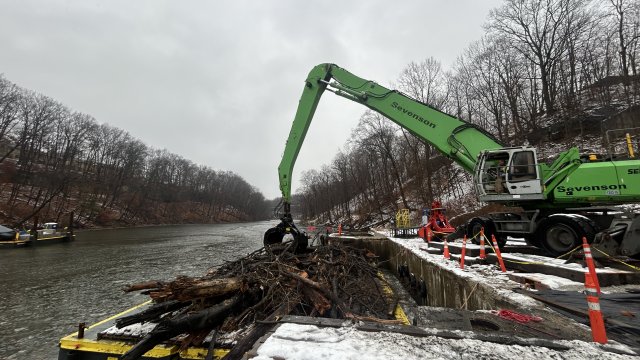
The team has begun clearing woody debris from the shoreline to make sure there is clear access to the full dredging area. This will ensure there are no delays when work starts up again in 2026. Once the debris is collected, a Sennebogen 860 offloads it from the barge. The debris is then sorted based on size and stored at the Debris Management Pad.
-
The sand dredge barge has been secured upriver while dredging is paused for the holiday break.
-
With the cold winter weather, in-water work has paused for the season. Before the holiday break the team is performing equipment maintenance, including replacing the hydraulic power pack on the PC360 debris barge, to ensure it is ready to resume work after the break.
-
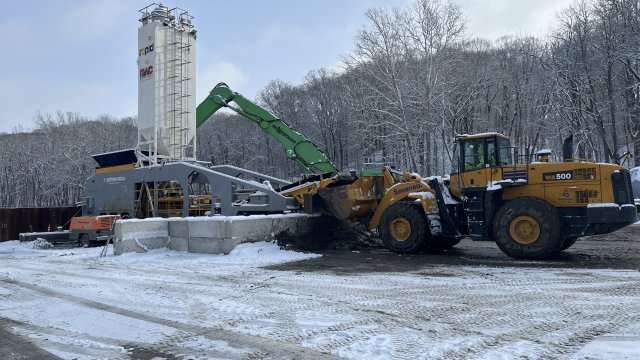
The Sevenson team is starting the pugmill operations and currently calibrating the system to ensure the proper dose of Portland cement is being used to achieve strength requirements to produce the stabilized material. Seen here is the pugmill conveyor transporting the sediment that has been mixed with Portland cement into a front-end loader. This material will be placed in the sediment placement area once the calibration is completed.
-
The Komatsu PC800 excavator is dredging sand from the upstream portion of the dam pool. Once dredged, the sand is transported via pipeline to the sediment placement area, where it is stockpiled for further use or processing.
-
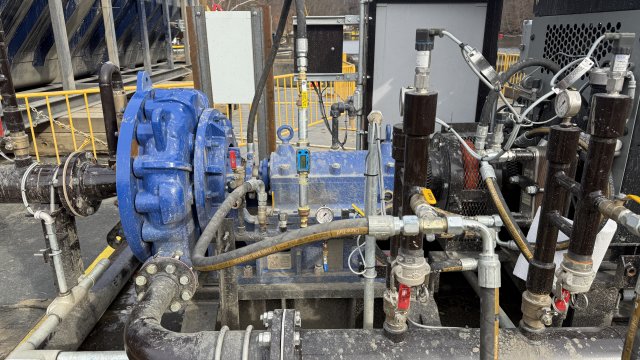
A flow meter has been installed on the silt booster service water pump to assist with adjustments during dredge operations to ensure silt material with the correct percent solids is being transported to the sediment processing area.
-
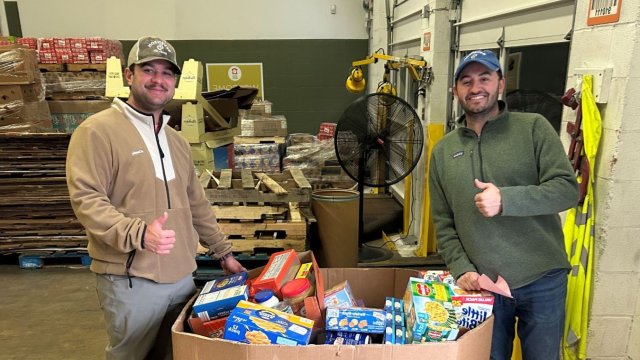
The Sevenson team donated over 2,400 meals to the Akron-Canton Regional Foodbank.
-
Stockpiled sand from the upstream sand dredging that is being stockpiled for further use or processing after having been separated from larger debris in the Total Clean Desander.
-
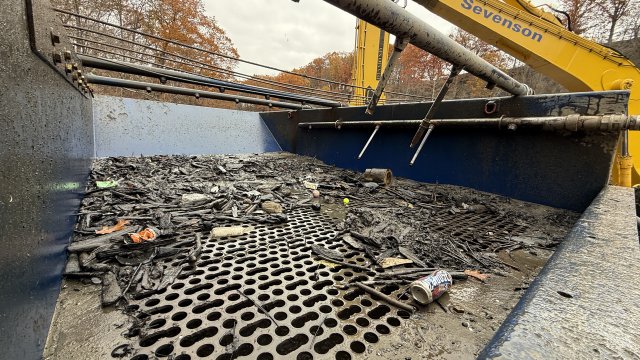
Larger debris is separated out from the sediment during dredging using screens that catch the material. Once a significant amount of debris is accumulated, it is offloaded from the barge to the Debris Staging Area before it is characterized and sent to a landfill for disposal.
-
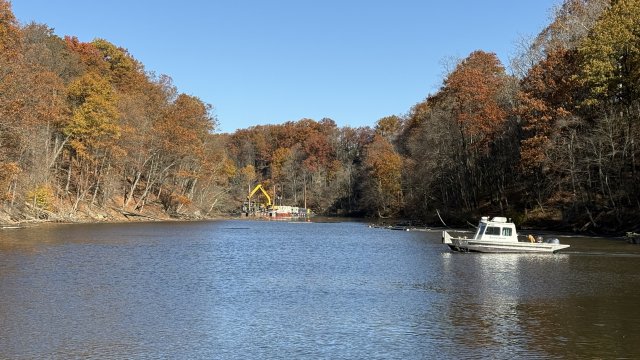
A boat is collecting bathymetric survey data of the dredging area. Bathymetric surveys measure the depth and shape of the underwater landscape. The team uses this data to assess how much sediment has been removed during dredging operations.
-
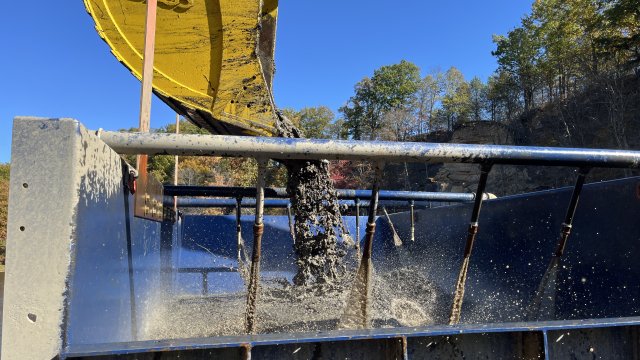
Sandy dredge material is being dumped into the shaker on the barge in the dam pool. Once screened to remove larger material, the dredged sand is pumped down to the total clean system where it is separated from finer sediment and stockpiled for further use or processing.
-
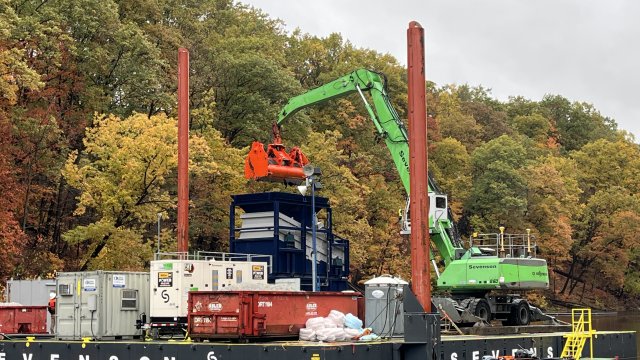
Silt dredging has begun in the downstream portion of the dam pool. The Sennebogen 860 excavator on the dredge barge is preparing to dump a bucket of dredge material into the shaker and slurry tank to separate the fine sediment from larger debris. From there, the sediment will be pumped down to the surge basin in the Sediment Processing Area.
-
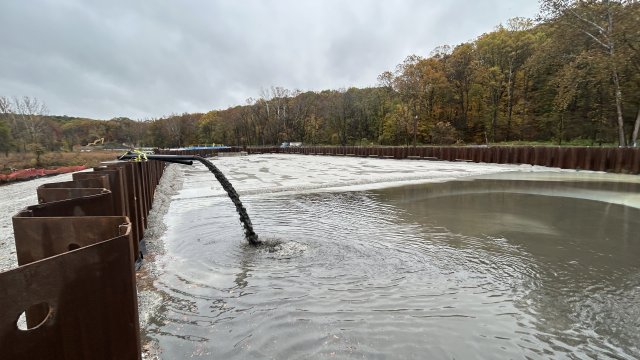
Fine grained sediment discharging from the pipeline into the surge basin in the Sediment Processing Area during dredge operations. The surge basin can hold approximately 3 days worth of dredge material to allow processing to continue even if there is a pause in dredging.
-
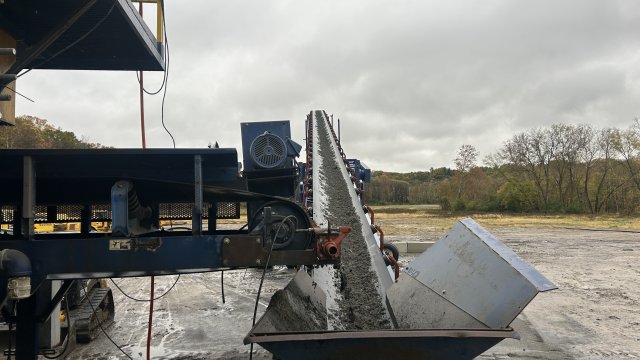
Material is being transferred from the Total Clean Desander to a conveyor at the Sediment Processing Area. The sand is being stockpiled in the Sediment Processing Area for further use or processing.
-

At the Sediment Processing Area, a liner is installed for the Modutank. The Modutank will be used to temporarily store excess water during dredging operations.
-
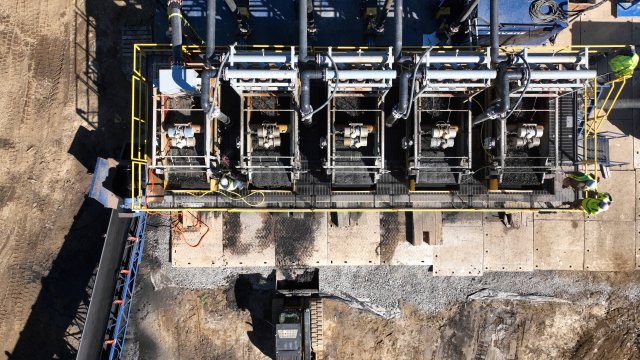
An overview of the total clean de-sanding system unit during operations. Dredged sediments are washed to separate debris and coarse-grained sandy materials.
-

An aerial image of the dredging operations looking southwest towards Front Street Bridge.
-
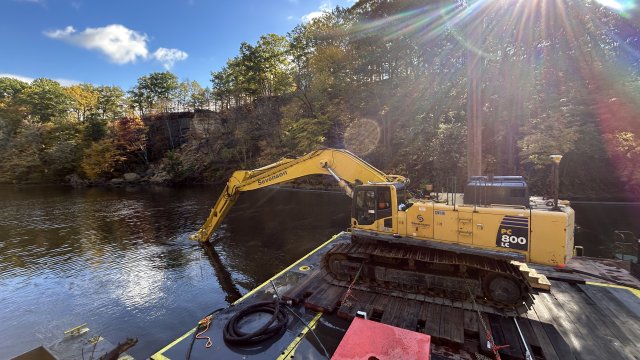
The Komatsu PC800 Excavator removes sediment during dredging operations in the upstream portions of the Gorge Dam Pool.
-

Hydrostatic testing is being performed on the HDPE dredge pipelines that will carry sediment from the dam pool down to the sediment processing area. These pipelines are tested 150% higher than the operating pressure of the pipeline to ensure that any weaknesses within the pipeline are discovered before dredging operations are underway.
-

The fully assembled Komatsu PC800 Excavator will be used to dredge course-grained sand from upstream in the dam pool.
-

The barge hosting the Komatsu PC800 is completely set up and ready to be deployed upstream to begin sand dredging.
-

Aerial view of the total clean desanding system that will be used to separate sand from dredged sediments. The separated sand will be stockpiled for further use or processing.
-

Aerial overview of the former power plant area that is being prepared for dredging operations to begin. This area will serve as the staging area for dredging operations.
-

A ravine crossing bridge is being constructed along the High Bridge Trail to support the pipeline as it crosses the ravine on its way to the sediment processing area. This shows the bridge partially constructed, approaching the landing at the western abutment.
-

The dredge pipelines need to cross under Peck Rd to get to the placement site and construction crews are seen here pouring flowable fill material to fill the road cut. Once the flowable fill cures, the roadway can be finalized by re-covering it with a 6-inch concrete surface.
-

Turbidity monitors are installed in the river to monitor water quality during dredging operations.
-

The dredged sediment processing pad receives the final 2 inches of asphalt and is now complete. This processing pad will hold equipment to amend dredge sediment with Portland cement before transporting to the sediment placement cells.
-

Crews prepare the barge that will be used to dredge high sand-content material, including a slurry tank with a shaker screen that will be used to keep large debris from entering the sediment transport pipeline.
-

An aerial image of the sediment surge basin and the sediment processing pad behind it. Preparations of the processing area continue for dredging activities to begin.
-

Crews continue to install stone and wood mats for the temporary HDPE dredged sediment transport pipeline on Highbridge Trail.
-

Sevenson crews install a 40-Mil Geomembrane Liner along the bottom of the sediment surge basin. This liner, along with stone, geotextile fabric, and concrete, will contain the sediment within the basin.
-

An aerial view of the sediment surge basin after completion of the 40-mil liner installation. The area is now prepared to receive additional geotextile fabric and stone. This basin will be the first stop for sediment before it is processed for disposal.
-

Crews move an excavator onto the 40'x60' Debris Barge to prepare for shoreline debris removal in the Gorge Dam Pool. Debris removal is a crucial first step to ensure that dredging can proceed unimpeded.
-

Crews begin construction of the ravine crossing bridge by installing abutments and steel piling at the western landing of the ravine on Highbridge Trail.
-
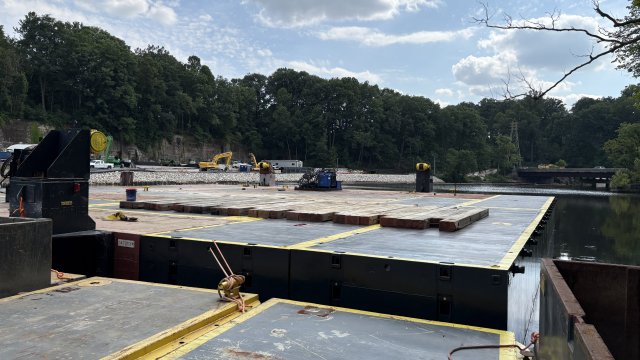
An 80’x80’ barge being constructed before dredging begins. This barge is a floating platform on the water that will hold dredging equipment that will remove the sediment from the Cuyahoga Gorge dam pool.
-

A mechanic workshop was constructed near the sediment processing area on Peck Rd where on-site equipment repairs and fabrication can take place.
-

Aerial view of the sediment processing and placement areas, including the newly constructed dredged sediment surge basin outlined with sheetpile walls. During dredging, sediment will be pumped from the dam pool to the dredged sediment surge basin before being mixed with additives to stabilize and solidify the sediment in the processing area. Once processed, the stabilized and solidified sediment mixture will be transferred to the placement area.
-

Existing soils in the sediment surge basin are being graded to prepare the area before installation of an HDPE liner. The liner will contain the sediment within the sheet pile. The surge basin will hold up to 7000 cubic yards of sediment and will be the first stop for sediment as it travels from the dam pool to its final placement in the sediment placement area.
-

Equipment is being installed to monitor underground utilities throughout the construction area to make sure an underground sewer is not disturbed during construction operations.
-

The installation of steel sheet piling is ongoing and will create a sediment staging basin once it is complete. This is where sediment will be pumped to before being processed and placed in the sediment placement area.
-
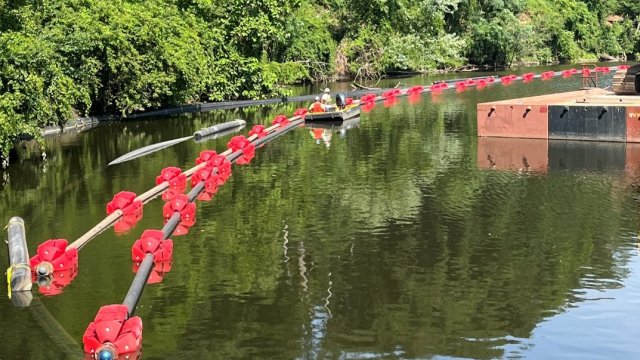
Sevenson’s crews are attaching pipe floats to the dredge pipeline that will be floating on top of the Cuyahoga River before being routed up onto the Highbridge Trail. These floats are bright red which allow the pipelines to be seen and easily inspected.
-

After fusing, 500 ft lengths of HDPE pipe are being staged along Highbridge Trail as the first step in pipeline construction. The pipeline will carry all the dredged contaminated sediment from the dam pool down to the sediment processing area where it will be mixed with cement before being being placed in the placement area.
-
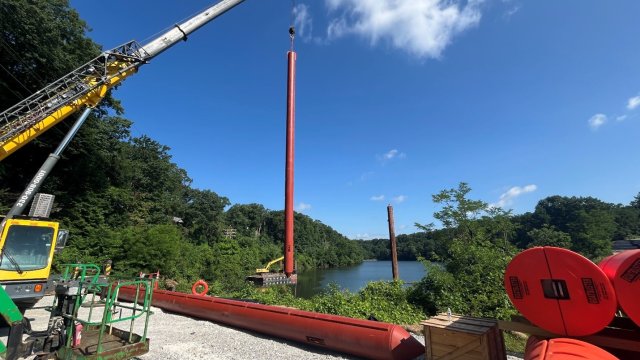
Sevenson’s crews used a crane to install 65-foot spuds onto their barge on the North side of the Front Street bridge. The spuds are driven into the bottom of the river to anchor the barge for stability and so it does not move during sampling or dredging.
-
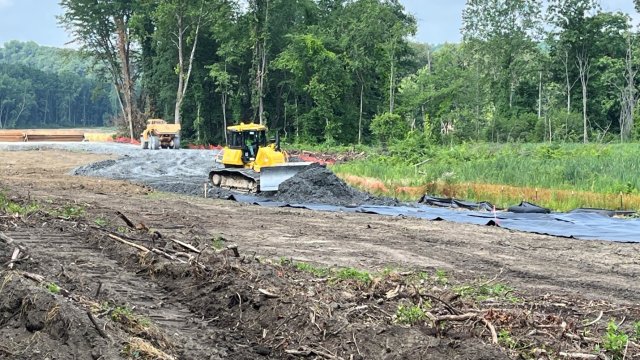
Shale excavated from the City of Akron North Side Interceptor Tunnel (NSIT) project is being used to create temporary roads for the heavy equipment that will be used in the sediment processing site.
-
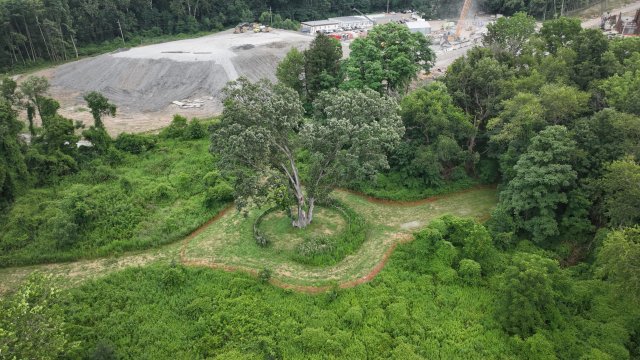
Fencing was installed around the nearby Signal Tree to protect the tree while construction is ongoing in the Cascade Valley Metropark.
-
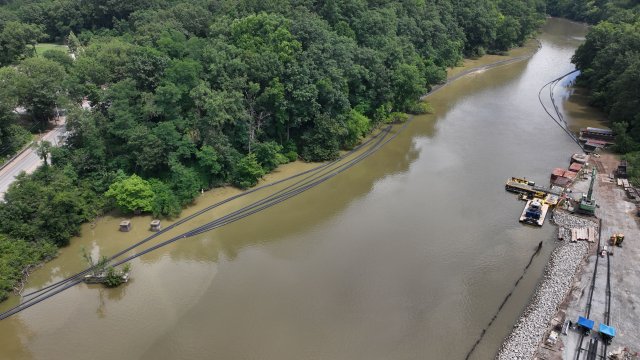
Aerial view of the Dredge Staging Area, with HDPE pipe staged in the Cuyahoga River. Once complete, the pipeline will transport sediments dredged from the river two miles downstream to the sediment processing and placement areas.
-
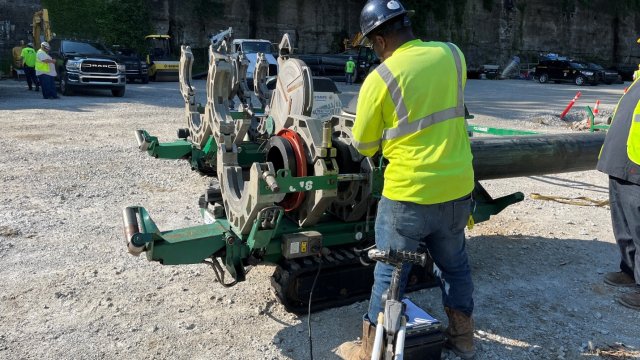
A worker is fusing a section of the HDPE pipe that will carry the dredged sediment from the dam pool to the placement area.
-
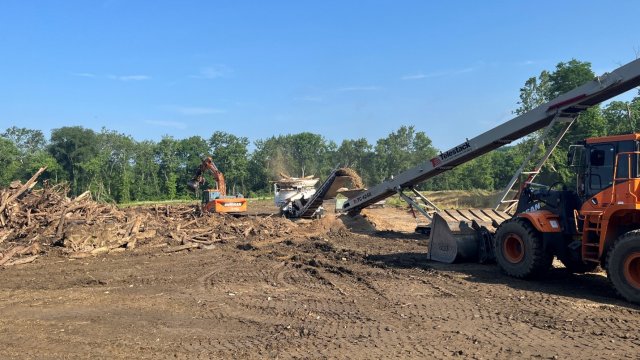
All the tree stumps and felled trees in the sediment placement area are being chipped and shredded to make space for where the dredged sediment will eventually be placed.
-
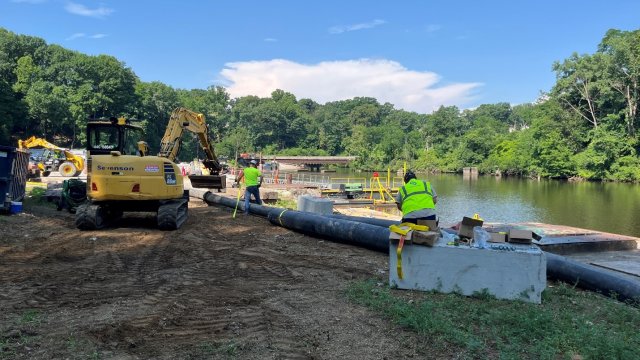
Crew members are attaching pipe floats to the 12-inch pipeline that will bring dredged material from the dam pool to the sediment placement area. These floats are capped and sealed to allow the pipeline to float on top of the river.
-
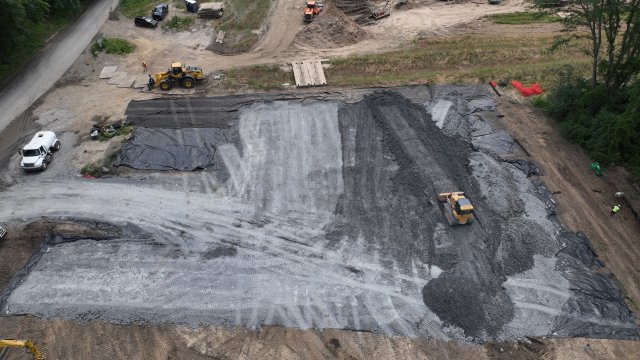
An aerial view of the future sediment processing area where shale is being placed and graded over nonwoven fabric. In the future this will be the area where a pugmill will mix cement with the dredged sediment to stabilize the sediment before placing in the placement area.
-
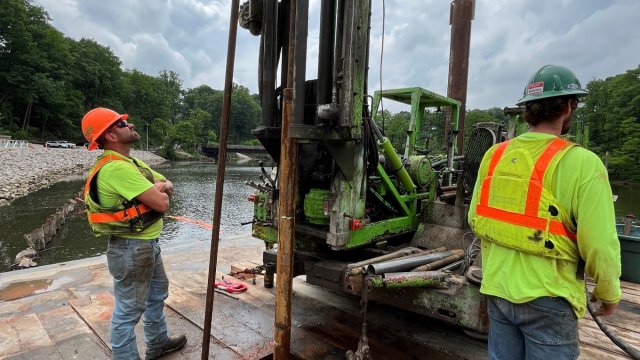
Sediment boring samples were drilled in the river near the former Ohio Edison power plant area to get a better understanding of how the sediment material is layered above the bedrock.
-
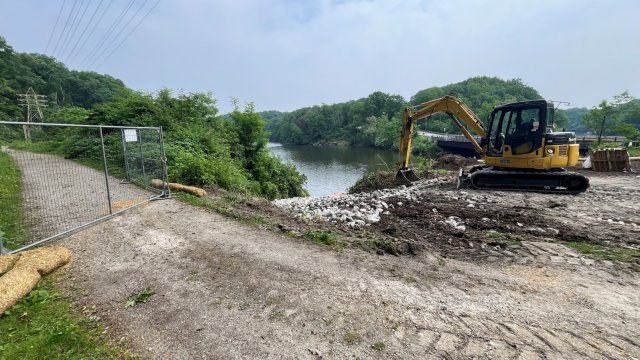
Due to the low height of the bridge, crews are creating a safe entrance to allow for marine equipment to be launched into the river from the North side of the Front St. Bridge.
-
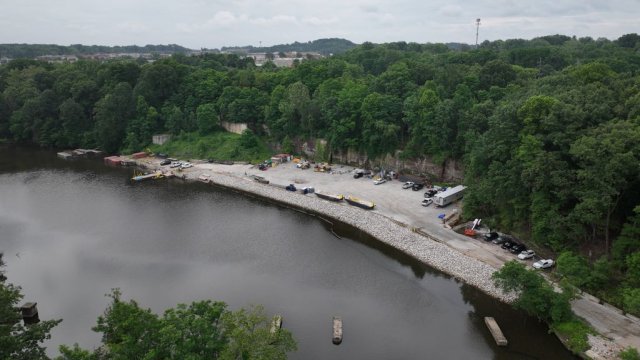
An aerial view of the former Ohio Edison power plant, that will serve as the Dredging Laydown Area for the GLLA Cleanup Project.
-
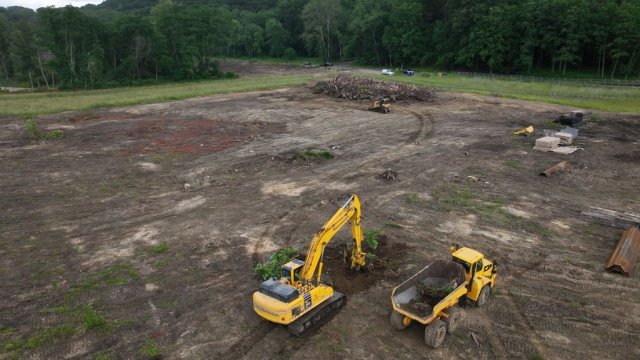
Crews continue to clear and grub stumps and debris in the Sediment Placement Area. The material that is removed from the river will be stabilized and placed here.
-
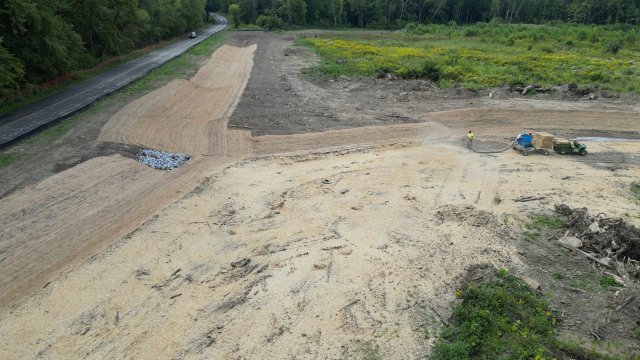
View of the Sediment Placement Area looking south. The contractor is pictured seeding the site to help control erosion before the dredged sediments are placed here next year.
-
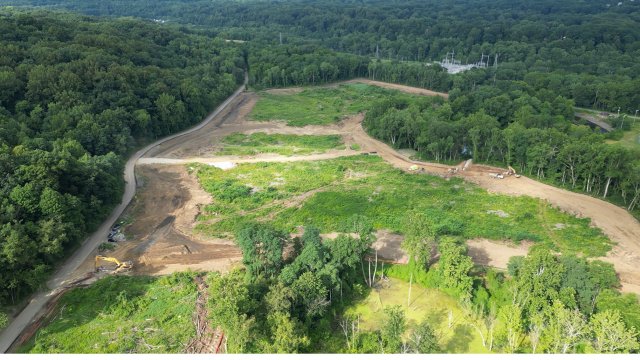
View of the site looking south, contractor is clearing the site and beginning construction of the ditches and outfalls.
-
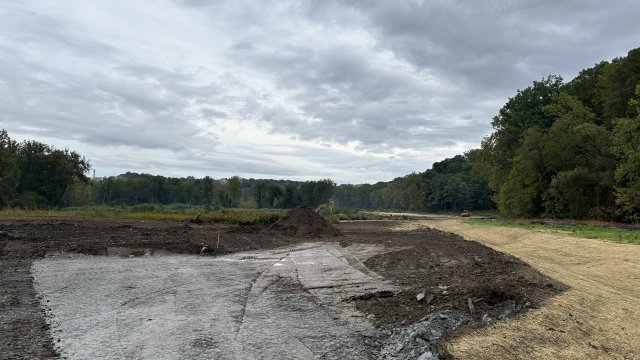
View of the Sediment Placement Area looking north. The left side of the picture shows compacted fill material that contractors placed in the upland area of the site. The right side of the picture shows a ditch that was recently seeded to prevent erosion.
-
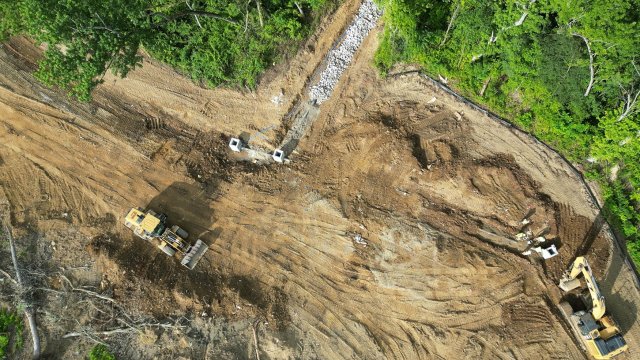
Aerial view of contractors installing outfall 2 at the Sediment Placement Area.
-
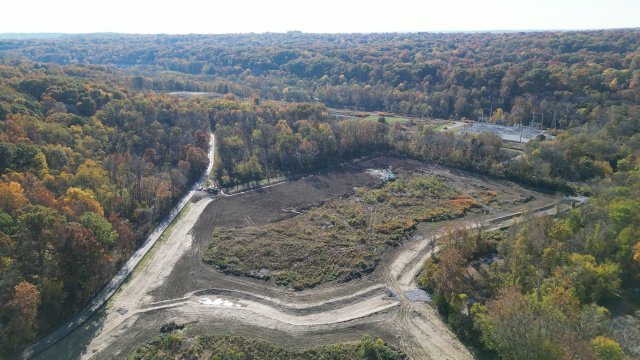
Aerial view of the Sediment Placement Area looking south, showing outfalls 3 and 4 on the right side of the picture.
-
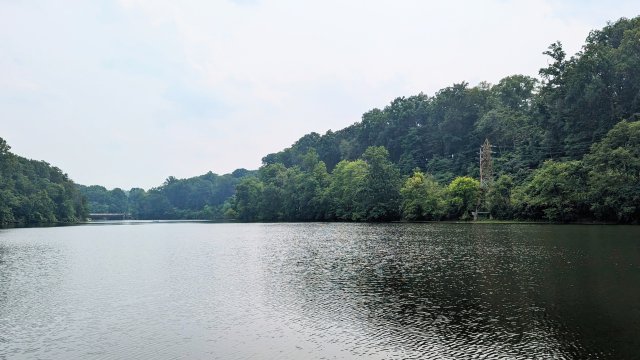
Upstream view of the Gorge Dam pool with the Front Street bridge in the distance.
-
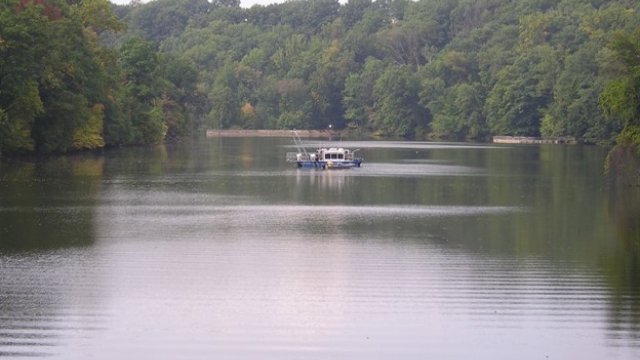
Downstream view of the Gorge Dam pool where former EPA vessel, the RV Mudpuppy, samples for contaminants in sediment. (Photo Credit: Elaine Marsh, Summit Metro Parks)
-
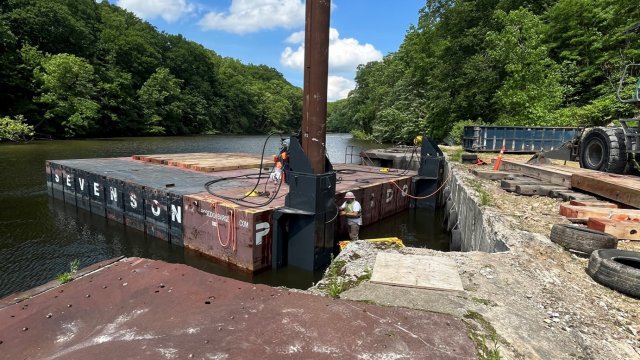
The crew installs spuds onto the dredging barge. The spuds work as an anchor for the barge to allow for easier and more precise dredging.
-
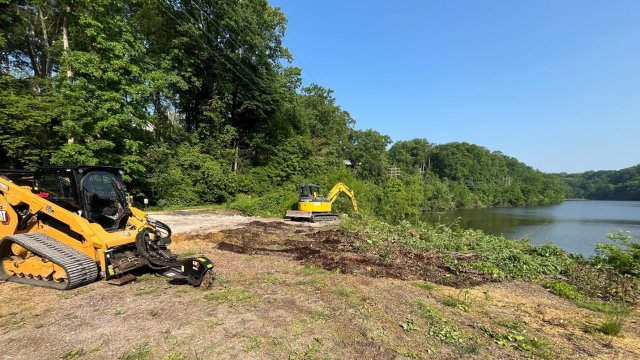
Preparations begin at the Highbridge Trail parking area to allow for the safe launching of marine equipment for future sediment removal on the west side of the Front Street bridge.
-
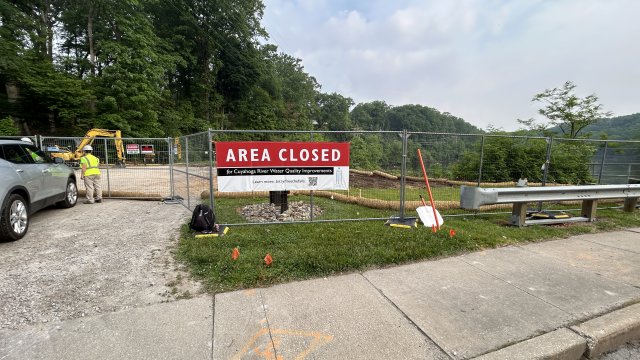
The Highbridge Trail was closed to the public by Summit Metro Parks on June 4, 2025.
-
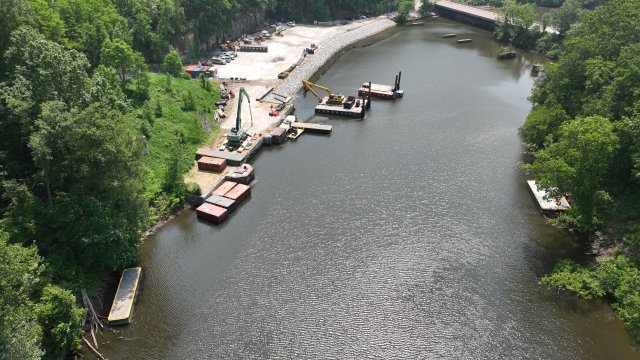
Preparations begin at the Highbridge Trail parking area to allow for the safe launching of marine equipment for future sediment removal on the west side of the Front Street bridge.

